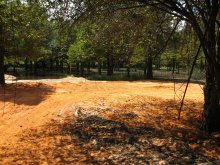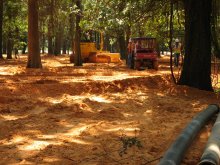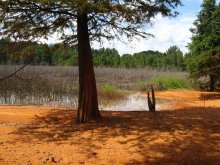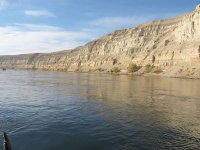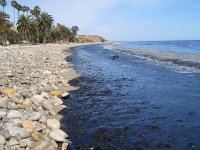Ciba-Geigy
Hazardous Waste Site | McIntosh, Alabama | 1950s to Present
What Happened?
Beginning in the 1950s, the Ciba-Geigy facility manufactured the pesticide DDTdichloro-diphenyl-trichloroethane; chemical compound manufactured for use as a pesticide until it was banned in the U.S. in 1972. DDT remains in the environment for many decades, accumulates in living creatures, and poses health hazards to humans, wildlife, and fish. and other chemicals. Manufacturing waste and other hazardous substances were released into unlined pits on the property, and discharged into the adjacent Tombigbee River and its floodplain until 1963.
EPAU.S. Environmental Protection Agency; federal agency with the mission to protect human health and safeguard the environment. designated the Ciba-Geigy property as a Superfund siteAn uncontrolled or abandoned place where hazardous waste is located, possibly affecting local ecosystems or people. Sites are listed on the National Priorities List for evaluation and cleanup by the U.S. Environmental Protection Agency. in 1984. NOAA and other state and federal partners provided technical assistance to EPA throughout the multiphase cleanup. In Phase 1 (completed in 1998) crews removed the top 12 inches of contaminated soil and sediment from approximately 12 acres of floodplain, and capped the area with sand. In Phase 2 (completed in 2008), crews capped approximately 40 acres of floodplain and wetlands with clean sand and organic material.
What Were the Impacts?
Elevated concentrations of total DDT (DDTralso known as total DDT; the sum of six DDT-related compounds.) have been found in fish, soil, and sediments in various habitats at the site. Contamination extends to the Tombigbee River and its adjacent floodplain and bottomland hardwood forest. DDT persists in the environment for many years and can become concentrated in animal tissue as it moves up the food chain.
The Tombigbee River and its floodplain support many species of fish including striped bass, Alabama shad, American eel, striped mullet, Gulf sturgeon, and shellfish. Preliminary investigations of the site indicate that DDT and its degradation products have caused injuries to bottom-dwelling organisms, fish, and birds.
What’s Happening Now?
In 2005, NOAA and other trustees initiated a cooperative Natural Resource Damage Assessment (NRDA) with the responsible party. The goal of the NRDA is to assess injuries to natural resources and plan restoration to address those losses.
A settlement was reached with the current owner of the property, BASF Corporation, in 2013. The agreement provided $3.2 million for restoration projects. The trustees have planned restoration activities focusing on the Tombigbee River and throughout the northern portion of the Mobile-Tensaw River Delta.
NOAA and trustees completed a Final Damage Assessment and Restoration Plan/Programmatic Environmental Assessment for the Ciba Geigy – McIntosh Plant in 2017. Land acquisition was identified as a preferred project alternative in the RP/PEA, including enhancing and restoring habitat on existing state-owned lands, and habitat enhancement and restoration of newly acquired lands. In early 2021 the trustees completed the acquisition of two tracts of seasonally flooded bottomland wetlands near the Mobile River called the Rigsby Tract and the Simmons Tract, totaling over 330 acres of protected habitat
“At the Ciba site, the trustees are considering alternatives that would help restore bottomland hardwood forests that are important to maintaining flora and fauna species diversity and high quality wildlife habitat.”
Dan Van Nostrand
NOAA Marine Habitat Resource Specialist
Contacts
Dan Van Nostrand
NOAA Restoration Center
Mobile, AL
(251) 544-5015
dan.van-nostrand@noaa.gov



